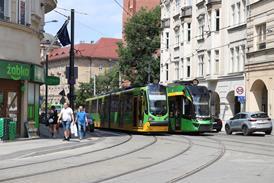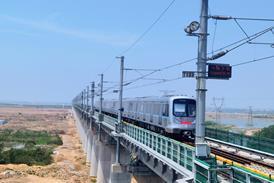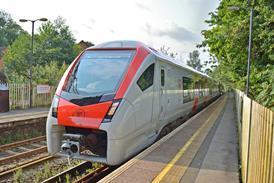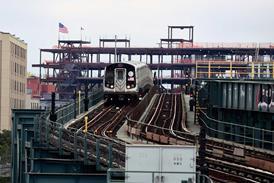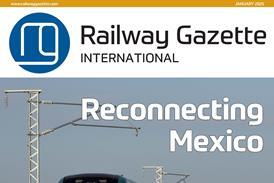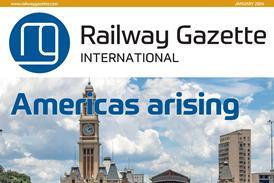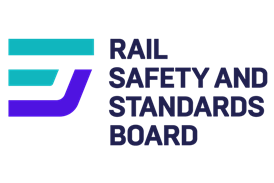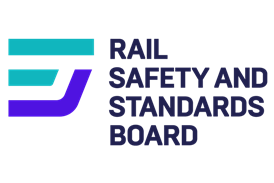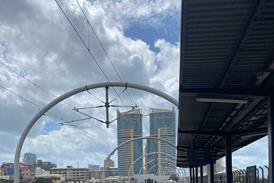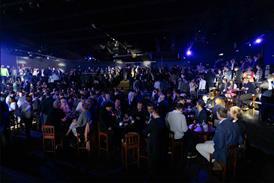INTRO: The railway laboratory is four years old. In the time since Railtrack was set up, Britain’s railway network has been split up, sold off, and in some cases recombined. The hiatus in investment which threatened to kill the indigenous supply industry has given way to a flood of orders for new and refurbished rolling stock
MOST CONSTITUENT parts of what was British Rail have now been in private hands for nearly two years. During the time that franchises and sales were being confirmed, there was considerable doubt - including in our own pages - that the process was in the best interests of the industry. What justification could there be to inflict yet more stress on Britain’s railway, particularly in view of its good financial performance in the late 1980s after the last restructuring?
In 1994 we described Britain’s network as the ’world’s biggest railway laboratory’ - an unconventional, unproven and unwanted privatisation (RG 4.94 p217). Now the experiment is beginning to produce positive results - although the complete picture is still unclear and performance has been buoyed up by a booming economy. What would happen if recession returns, perhaps coinciding with the planned reduction in government grant, is another matter.
Meanwhile, there are obvious signs of improvement. Perhaps the most impressive is in the freight sector. Although the previous government went to great lengths to split the business into six separate entities, a Wisconsin Central-led group subsequently purchased five of these, and reassembled them as English Welsh & Scottish Railway.
Inspired by the vision of Chief Executive Ed Burkhardt, EWS has begun a rapid turnaround. New rolling stock has been ordered: 250 locos from General Motors, with 30 more coming from GEC Alsthom Transporte in partnership with GM. No less symbolic are 2500 wagons from Thrall Europa, the first of which is poised to roll out of the former Adtranz EMU plant at York. EWS has also absorbed the open access rail operations of electricity generator National Power, although BNFL subsidiary Direct Rail Services continues to expand its small fleet.
Meanwhile intensive EWS marketing has begun to win back traffic lost to road, and gain new customers. Freight is moving over routes serving industries abandoned by BR - grain from East Anglia to Scotland, timber from the Scottish Highlands to mid-Wales, and even mixed freight to and from the far north of Scotland.
EWS has set itself the target of trebling freight tonnage in 10 years. From yesterday’s viewpoint that would be impossible - from today’s, perhaps optimistic. Yet Railtrack’s 1998 Network Management Statement unveiled at the end of March anticipates at least a doubling of freight traffic - with clear implications for the need to expand capacity and tackle bottlenecks. There is also an emerging strategy to develop a core network of routes with enhanced loading gauge clearance for piggyback and larger containers.
Franchise progress mixed
To much of the British public, the face of the railway continues to be the commuter operations into London. Perceptions of progress have not been good - some badly-managed incidents in 1997 attracted much adverse publicity, while deteriorating infrastructure has prompted Her Majesty’s Railway Inspectorate to issue several Improvement Notices. Trains sporting glitzy new liveries and logos have sprung up all over the network, but all too often performance in terms of reliability has failed to match expectations.
Add to that tales of fat cats and fast profits (RG 4.98 p209), and it is clear that there is an urgent need for Britain’s railway industry to demonstrate quickly and effectively that things are looking up. Evidence of change can be seen in Railtrack’s station refurbishment programme, but the string of train orders placed in the last year will not bring obvious improvements until deliveries start later this year - and then only in penny numbers. For the big changes passengers still have some time to wait.
Mirroring to some extent what has happened in the freight business, control of the 25 passenger franchises is also being consolidated into larger groupings. During the initial franchising period, bus and airport operator National Express won no fewer than five rail operations. Prism Rail picked up four, and the remainder were spread into ones and twos.
This spring has seen further consolidation as some ex-BR management buy-out teams hand over control to their private sector partners. Great Eastern franchisee FirstGroup started the process by acquiring Great Western Holdings, in which it had a 24·5% stake, gaining control of the Great Western and North Western franchises. Shortly afterwards the MBO stake in the Thames Trains franchisee Victory Railways was acquired by partner Go-Ahead group, which also controls the Thameslink operation. And last month Liverpool-based bus group MTL Holdings, which holds the Merseyrail and Regional Railways North East franchises, cancelled plans for a stock market flotation and put its rail operations up for sale instead. The maps below show the current operational areas of the passenger franchise groups.
The face of the passenger business will start to change again next year, when the current rules restricting open competition on the tracks start to phase out. To get the franchises established in the private sector, Rail Regulator John Swift introduced Moderation of Competition rules to provide protection until 2002. Relaxation of MoC is due to start with the September 1999 timetable change, and the Regulator has been consulting over how this should proceed.
On March 31 Swift issued a policy statement confirming that he was minded to allow the introduction of competitive services using ’open access’ rules which can be shown ’to bring benefits to passengers without placing undue burden on the taxpayer.’ He envisages this will ’lead to the introduction of new services such as airport links, services to new developments, to shopping and leisure centres and park-and-ride sites, and cross-regional services.’
Rolling stock resurgence
Before the start of the privatisation process, British Rail was ordering around 350 to 400 passenger vehicles a year to maintain the age profile of its 11000 strong fleet. But the restructuring led to a 1064 day hiatus during which no new coaches were ordered. Chiltern Railways broke the logjam in October 1995 with a symbolic order for 12 DMU cars from Adtranz, and this has led to a flood of orders from 16 of the 25 franchisees. Because of the length of the franchises, most vehicles are due for delivery between 1999 and 2001, and the average does not reach the old BR figure. But the factories are humming again.
Many of the franchisees were committed to ordering some new stock under the terms of their concessions, but several have placed further orders as they see their markets developing (Table I). Stagecoach-owned rolling stock leasing company Porterbrook has also ordered two batches of ’speculative’ diesel multiple-units to meet short-term demand.
There are more significant orders due this year. Virgin Trains has selected builders for over £800m of new trains, which will renew almost its entire fleet, and is due to sign the contracts shortly. Virgin West Coast is buying the world’s biggest single batch of tilting trains: 55 eight-car sets from Fiat Ferroviaria with GEC Alsthom traction equipment. Virgin CrossCountry has selected Bombardier for its diesel fleet, which will comprise 43 four-car tilting DEMUs, with a further 36 diesel locos and 140 coaches running as push-pull sets. The locos will have GM EMD 3300hp diesel engines, while the DEMUs will have MTU power units.
Last year, French-owned Connex Rail ordered 30 four-car Class 375 ’Electrostar’ EMUs from Adtranz for £90m, to operate Connex South Eastern services from London to Dover and Hastings. The contract includes options for up to 800 more cars, up to half of which could be for the neighbouring Connex South Central franchise if it is extended to 15 years (p337). And on March 31 ScotRail announced the last of the franchise commitment orders when it agreed to buy 40 three-car EMUs from GEC Alsthom.
The need to raise private sector finance for new rolling stock was the primary reason for the creation of the three rolling stock leasing companies, and the structure of high lease payments by train operators to generate a revenue stream. But this enabled the initial owners of all three companies to resell the businesses and make substantial profits (RG 4.98 p209) without placing the orders envisaged by the politicians. Since its takeover by Stagecoach, Porterbrook has funded two-thirds of all rolling stock orders, worth over £300m, and continues to make the running with innovative deals such as the ’no train no pay’ deal contract with Anglia Railways at the end of March. The other Roscos are also now active: Angel Trains is backing the Virgin deal, and Forward Trust Rail is to finance the ScotRail EMUs.
Investing in infrastructure
Railtrack’s 1998 Network Management Statement published on March 25 outlined planned investment totalling £17bn over the next 10 years. This breaks down into £5·5bn on maintenance, £7·9bn on renewals and £3·1bn on enhancements to improve capacity and capability. Overall plans for each of the eight zones are supplemented by 45 ’route strategies’, which include details of work and breakdowns of investment by category, although most of the enhancements are heavily qualified by the words ’possible’ and ’proposed’.
The NMS reveals a substantial increase in projected passenger and freight demand used by Railtrack for planning purposes. Railtrack has central forecast for 1998-2008 within a range of high and low scenarios (Fig 1). Passenger-km are expected to rise by 15% over the coming decade, having already recovered substantially from the 1994 trough. The 1998 base year figure itself appears pessimistic in that it assumes no growth over 1997, whereas Train Operating Companies and the Office of Passenger Rail Franchising continue to report a rising trend.
The high growth scenario - representing a 30% increase on 1998 to 42·5 billion passenger-km in 2008 - assumes road pricing, non-residential car parking taxes and increased fuel taxes. It is more cautious than the ’doubling by 2010’ which Chief Executive Gerald Corbett told the Commons Transport Sub-Committee last November that Railtrack had conveyed to government, indicating a rise to 65 billion passenger-km.
Of freight, the latest NMS says 1997-98 is ’expected to show at least a 5% growth in tonne-km over 1996-97’. Within that total, ’intermodal and international traffic is now growing by 12% and 20% per annum respectively’.
Railtrack tends to quote freight volumes in gross tonne-km, but the forecasts are expressed in net tonne-km (the difference is substantial). Central forecast for 2008 is an 80% rise on 1998, with the lower end at 40% broadly in tune with last year’s NERA study commissioned by the Rail Regulator. The top of the range, at 200%, is described as ’similar to English Welsh & Scottish Railway’s target’.
These forecasts, freight in particular, are not compatible with current network capacity constraints. Railtrack has identified 15 places where congestion is already limiting growth, and the NMS locates a further 11 where congestion is expected to occur. Unless these are dealt with, the high-growth scenario cannot be accommodated and even the 80% central forecast must be in question. o
CAPTION: Virgin Trains won the former InterCity West Coast and CrossCountry franchises. An ambitious plan will see increased frequencies and shorter journey times as new trains are delivered by GEC Alsthom and Fiat Ferroviaria for the West Coast, and by Bombardier for CrossCountry. Virgin chief Richard Branson (centre) announced the details in London on March 3
CAPTION: The first Class 66 loco for freight operator EWS was due to reach Britain on April 20. After assembly at General Motors’ plant in London, Ontario, the loco was taken by rail to Albany, New York, for shipment across the Atlantic
CAPTION: Empire builders. Franchising split the passenger network between more than a dozen operators. These are shown on two maps for clarity. Connex routes are shown on p337
CAPTION: Fig 1. Projections of passenger (top) and freight growth, as detailed in Railtrack’s Network Management Statement. Analysis of route capacity indicated 15 bottlenecks which are already restricting growth, and 11 more where congestion is expected to develop in the next decade
TABLE: Table I. British rolling stock procurement
Operator Franchise Train order (to be ordered) Builder
Connex South Eastern 30 x 4 car DC EMU Adtranz
(97 x 4 car DC EMU) Options with Adtranz
GB Railways Anglia 8 x 3 car DMU (12 x 3 car option) Adtranz (part of Porterbrook build)
First Group North Western Trains 70 DMU cars GEC Alsthom
Great Western Trains 8 x 5 car DMU GEC Alsthom
32 DMU cars GEC Alsthom
Great Eastern (24 x 4 car Class 312 Classic conversion) Adtranz
M40 Trains Chiltern 5 x 4 car DMU Adtranz
MTL RR North East 16 x 3 car AC EMU Siemens
National Express Midland Main Line 17 x 2 car DMU Adtranz
Gatwick Express 8 x 8 car DC EMU GEC Alsthom
ScotRail 40 x 3 car AC EMU GEC Alsthom
9 x 3 car DMU Adtranz (part of Porterbrook build)
Prism Rail LTS Rail 44 x 4 car AC EMU Adtranz
Virgin Trains Virgin CrossCountry (36 diesel locos/140 push-pull coaches) Bombardier
(43 x four car tilting DEMUs) Bombardier
Virgin West Coast (55 x 8 car tilting EMU) GEC Alsthom / Fiat Ferroviaria
Commitments outside franchise agreement Status
Stagecoach South West Trains 30 x 4 car DC EMU GEC Alsthom Signed
Porterbrook Various 100 DMU cars (plus 100 car option) Adtranz Signed
National Express Central Trains 13 x 2 car DMU Adtranz (part of Porterbrook build)
Sea Containers GNER (2 to 8 x 11 car AC tilting trains) Fiat/GEC Alsthom Heads of agreement
EWS EWS 250 diesel locos GM EMD Signed
EWS 30 x 200 km/h diesel locos GEC Alsthom Transporte/GM EMD Signed
EWS 2500 wagons Thrall Europa Signed

